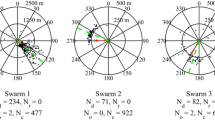Abstract.
This study views a honey bee swarm as a supraorganismal entity which has been shaped by natural selection to be skilled at choosing a future home site. Prior studies of this decision-making process indicate that swarms attempt to use the best-of-N decision rule: sample some number (N) of alternatives and then select the best one. We tested how well swarms implement this decision rule by presenting them with an array of five nest boxes, only one of which was a high-quality (desirable) nest site; the other four were medium-quality (acceptable) sites. We found that swarms are reasonably good at carrying out the best-of-N decision rule: in four out of five trials, swarms selected the best site. In addition, we gained insights into how a swarm implements this decision rule. We found that when a scout bee returns to the swarm cluster and advertises a potential nest site with a waggle dance, she tunes the strength of her dance in relation to the quality of her site: the better the site, the stronger the dance. A dancing bee tunes her dance strength by adjusting the number of waggle-runs/dance, and she adjusts the number of waggle-runs/dance by changing both the duration and the rate of her waggle-run production. Moreover, we found that a dancing bee changes the rate of her waggle-run production by changing the mean duration of the return-phase portion of her dance circuits. Differences in return-phase duration underlie the impression that dances differ in liveliness. Although a honey bee swarm has bounded rationality (e.g., it lacks complete knowledge of the possible nesting sites), through its capacity for parallel processing it can choose a nest site without greatly reducing either the breadth or depth of its consideration of the alternative sites. Such thoroughness of information gathering and processing no doubt helps a swarm implement the best-of-N decision rule.
Similar content being viewed by others
Author information
Authors and Affiliations
Additional information
Electronic Publication
Rights and permissions
About this article
Cite this article
Seeley, T., Buhrman, S. Nest-site selection in honey bees: how well do swarms implement the "best-of-N" decision rule?. Behav Ecol Sociobiol 49, 416–427 (2001). https://doi.org/10.1007/s002650000299
Received:
Revised:
Accepted:
Issue Date:
DOI: https://doi.org/10.1007/s002650000299




